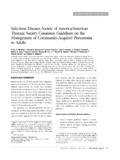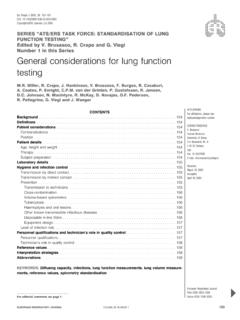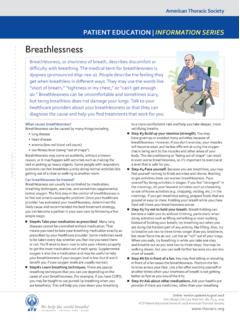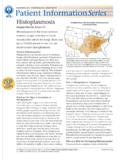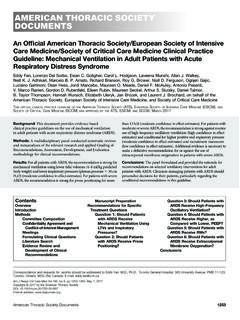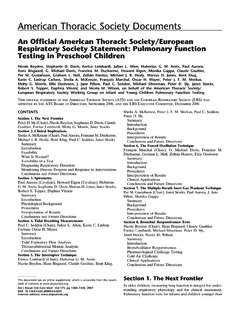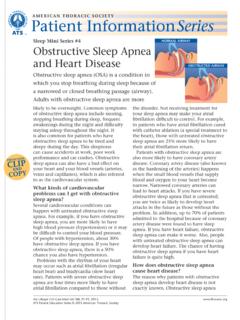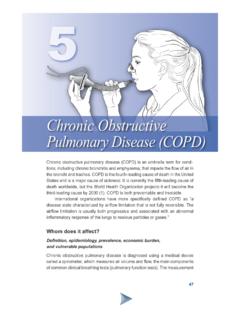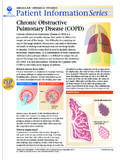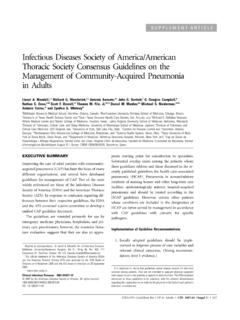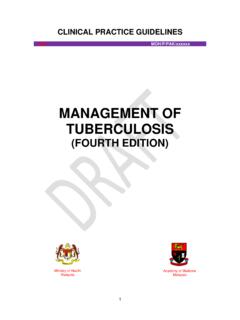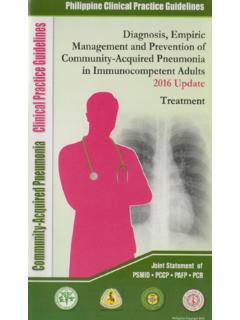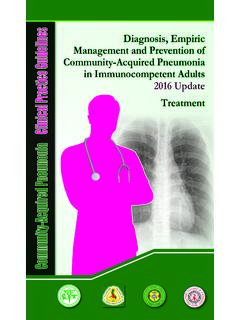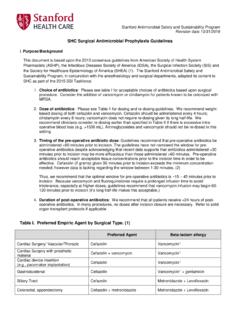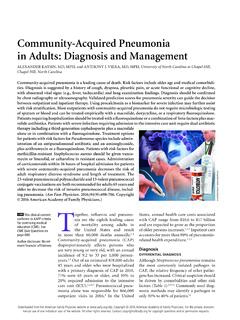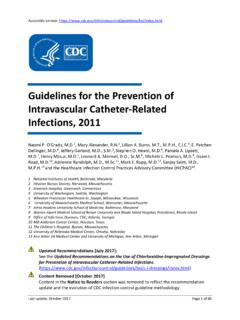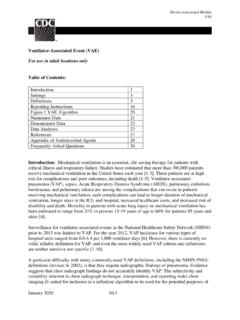Transcription of American Thoracic Society Documents
1 American Thoracic Society DocumentsAn Official American Thoracic Society Statement:Treatment of Fungal Infections in Adult Pulmonaryand Critical Care PatientsAndrew H. Limper, Kenneth S. Knox, George A. Sarosi, Neil M. Ampel, John E. Bennett, Antonino Catanzaro,Scott F. Davies, William E. Dismukes, Chadi A. Hage, Kieren A. Marr, Christopher H. Mody, John R. Perfect,and David A. Stevens, on behalf of the American Thoracic Society Fungal Working GroupTHISOFFICIALSTATEMENT OF THEAMERICANTHORACICSOCIETY(ATS)WAS APPROVED BY THEATS BOARDOFDIRECTORS,MAY2010 CONTENTSI ntroductionMethodsAntifungal Agents.
2 General ConsiderationsPolyenesTriazolesEchinocan dinsTreatment of Fungal InfectionsHistoplasmosisSporotrichosisBl astomycosisCoccidioidomycosisParacoccidi oidomycosisCryptococcosisAspergillosisCa ndidiasisPneumocystis PneumoniaTreatment of Other FungiGlossary of TermsWith increasing numbers of immune-compromised patients withmalignancy,hematologicdisease,andHIV ,aswellasthosereceivingimmunosupressive drug regimens for the management of organtransplantation or autoimmune inflammatory conditions, the in-cidence of fungal infections has dramatically increased over recentyears.
3 Definitive diagnosis of pulmonary fungal infections has alsobeen substantially assisted by the development of newer diagnosticmethods and techniques, including the use of antigen detection,polymerase chain reaction, serologies, computed tomography andpositron emission tomography scans, bronchoscopy, mediastino-scopy, and video-assisted thorascopic biopsy. At the same time, theintroduction of new treatment modalities has significantly broad-ened options available to physicians who treat these traditionally antifungal therapy was limited to the use ofamphotericin B, flucytosine, and a handful of clinically availableazole agents, current pharmacologic treatment options includepotent new azole compounds with extended antifungal activity,lipidformsofamphotericinB,andne werantifungaldrugs,includingthe echinocandins.
4 In view of the changing treatment of pulmonaryfungalinfections,theAmericanTho racicSocietyconvenedaworkinggroup of experts in fungal infections to develop a concise clinicalstatement of current therapeutic options for those fungal infectionsof particular relevance to pulmonary and critical care practice. Thisdocument focuses on three primary areas of concern: the endemicmycoses, including histoplasmosis, sporotrichosis, blastomycosis,and coccidioidomycosis; fungal infections of special concern forimmune-compromised and critically ill patients, including crypto-coccosis, aspergillosis, candidiasis, andPneumocystispneumonia;and rare and emerging fungal :fungal pneumonia; amphotericin; triazole antifungal.
5 EchinocandinThe incidence, diagnosis, and clinical severity of pulmonaryfungal infections have dramatically increased in recent years inresponse to a number of factors. Growing numbers of immune-compromised patients with malignancy, hematologic disease,and HIV, as well as those receiving immunosupressive drugregimens for the management of organ transplantation orautoimmune inflammatory conditions, have significantly con-tributed to an increase in the incidence of these diagnosis of pulmonary fungal infections has alsoincreased as a result of advances in diagnostic methods andtechniques, including the use of computed tomography (CT)and positron emission tomography (PET)
6 Scans, bronchoscopy,mediastinoscopy, and video-assisted thorascopic biopsy. At thesame time, the introduction of new treatment modalities hassignificantly broadened options available to physicians whotreat these conditions. Once largely limited to the use ofamphotericin B, flucytosine, and a handful of clinically availableazole agents, today s pharmacologic treatment options includepotent new azole compounds with extended antifungal activity,novel lipid forms of amphotericin B, and a new class of antifungaldrugs known as echinocandins. In light of all these developmentsin the incidence, diagnosis, and treatment of pulmonary fungalinfections, the American Thoracic Society convened a workinggroup on fungi to develop a concise clinical summary of thecurrent therapeutic approaches for those fungal infections ofparticular relevance to pulmonary and critical care practice.
7 Thisdocument focuses on three primary areas of concern: theendemic mycoses, including histoplasmosis, sporotrichosis, blas-tomycosis, and coccidioidomycosis; fungal infections of specialconcern for immune-compromised and critically ill patients,including cryptococcosis, aspergillosis, candidiasis, andPneumo-cystispneumonia; and rare and emerging fungal each fungal infection evaluated, the available literature hasbeen thoroughly reviewed and interpreted by the experts in-volved in this statement. In the search for published evidence,workgroup members reviewed journal articles and previouslypublished guidelines, and conducted an evaluation of electronicdatabases, including PubMed and MEDLINE.
8 In general, onlyarticles written in English were used in the final recommenda-Am J Respir Crit Care Med Vol 183. pp 96 128, 2011 DOI: address: The most relevant literature references are included in thispublication. Discussion and consensus among workgroup mem-bers formed the basis for the recommendations made in thisstatement. The authors reviewed the evidence base for eachmajor recommendation of this consensus statement and gradedaccording to an approach developed by the PreventiveServices Task Force (Tables 1 and 2). Although the AmericanThoracic Society (ATS) and Infectious Disease Society ofAmerica (IDSA) have recently adopted the GRADE approachto grading the quality of evidence and strength of recommenda-tions for clinical guidelines, the current project was initiated andmuch of the work was completed prior to the official adoption ofGRADE.
9 The recommendations included were, therefore,graded according to the system used in prior guidelines (1 3).Each section also includes expert interpretations regarding thebest approach for challenging clinical situations that have notbeen well studied in the literature, but that are the basis forfrequent consultation of the members of the ATS working groupon fungal infections. For convenience, a glossary of definitions ofuncommon terms is also included at the end of the member of the writing committee has declared anyconflict of interest, and every effort was made by the Chair asadjudicator to ensure that recommendations were free of any realor perceived conflict of interest; however, it should be noted thatthe process predates the official development and adoption of therevised ATS Conflict of Interest guidelines in 2008 (4).
10 ANTI-FUNGAL AGENTS: GENERAL CONSIDERATIONSIn most cases, treatment of fungal infections must be based onthe causative fungus, the severity of disease, and the clinicalfeatures of each patient. Specific guidelines for therapy, in-cluding dosing recommendations, are included in subsequentsections under specific organisms and infection site(s). Thissection will provide general comments about the major classesof available antifungal agents, including novel agents such asextended-spectrum triazoles and prototype of the polyenes is amphotericin B deoxycholate(amphotericin B), which continues to be a fundamental treat-ment option for severe fungal infections, particularly life-threatening illnesses, including aspergillosis, cryptococcosis,systemic candidiasis, and severe cases of histoplasmosis, blasto-mycosis, coccidioidomycosis, and zygomycosis.
